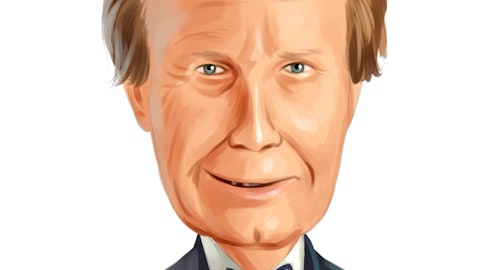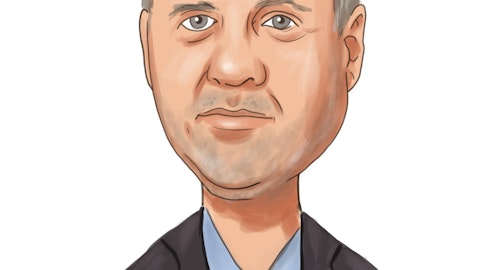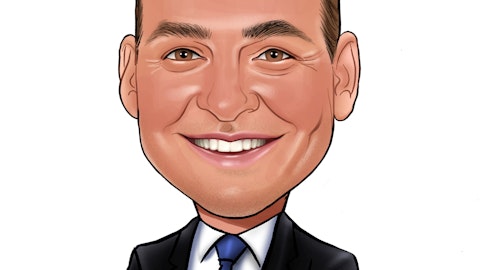George Gianarikas: Great. Thanks, guys. I will get back in queue.
Jim Clark: Alright. George, thank you.
Operator: Thank you. Our next question is from Aaron Spychalla with Craig-Hallum. Please proceed with your question.
Aaron Spychalla: Yes. Good morning, Jim and Jim, it’s Aaron Spychalla. Thanks for taking the questions. First for me, good to see your commentary on the second half outlook, can you just talk a little bit more maybe about the increased visibility you’re getting? In the past, you’ve talked about some of the multi-site projects and refresh cycles kind of compressing. Just trying to balance that outlook with some of the puts and takes with seasonality as we kind of look to 3Q?
Jim Clark: Yes. Well, seasonality is always something that we’ve talked about quite a bit. We have our focus in a lot of our product is outdoor and they are affected in ways that we just don’t €“ we can’t forecast or see. So any time we get into Q2 and Q3, we anticipate, expect some seasonality. Obviously, we backed that trend last year with a very, very strong Q3. And we’re backing it a bit this year with a very strong Q2. The unforeseeable events that happened in the Q, I don’t think that they structurally affect our momentum or our growth. But if you have a large snowstorm that affects construction activity for a week or 2 sometimes as they remove snow and things like that. It slows down project and it slows down some of the timing.
So Q2 and Q3 have always been a little bit of €“ had a little bit more variability to them, if you will. And then like I said, you just kind of underline in general, the fact that a big part of our business is outdoor. We do a very robust indoor obviously. But when outdoor weather is affected and that type of thing, we can anticipate some slowing. But again, like I said, last year was an exceptional Q3 and Q2 this year has been €“ it was obviously very strong as you guys have read. On the large project activity, these kind of things €“ our large projects tend to work over many month periods, sometimes years. And so the up or down that occurs within any given month of February or March or in August or September. We don’t really see that much.
They are kind of live events, if you will, but they don’t really affect the length or commitment of the projects. And many of the projects we’ve been engaged in are these larger projects. And specifically to one of the comments you made, what we see is if we went back 10 years ago, we saw a refresh cycle that was much closer to, we will say, an average of 7 years. If we go back 5 years ago, we saw a refresh cycle that was starting to come under 7 years and bouncing between 5 to 7 years. And now as we look at things today, we’re seeing a refresh cycle that’s solidly in the 5 in fact, trending lower all the way down to 3 years. And I think it speaks a lot to the fast pace of €“ we always say the TikTok generation, which is to just keep the image looking fresh and new and attracting customers that create an environment where the customers we’re dealing with are showing to their customers that they are keeping pace, they are continuing to invest in their properties and their offerings, and it’s just to kind of capture that attention of the consumer, which is just those emotions and the buying habits and those type of things are just moving a lot faster.
So we obviously see it as a very positive trend for our business.
Aaron Spychalla: Great. Thanks. Thanks for the color there. And then maybe just can you talk about some of the new products that you have launched over the last couple of years? I know you have refreshed completely some verticals and you kind of called out indoor this quarter. Can you just kind of talk about how that’s helped and maybe some of the areas that you are kind of focused on going forward?
Jim Clark: If I go back 4 years ago, I remember us getting on a call and saying we were going to have almost 20 new products launched in the year. And since that time, we have kept that pace plus and those products are not necessarily €“ they are not game-changing technology products as much as they are tweaking existing product lines. Don’t get me wrong. We do have the game changers, by the way. But the core of it is taking our core products and just incrementally making them better to serve our customers better, particularly as we continue to orient ourselves around vertical markets. We have a lot that serve a variety of markets, and that will never go away that these products can be applied to a number of markets. But the learnings we walk away from in our vertical markets, we try to incorporate into our products, whether it’s easier to install or more controls aspects or variations in lighting, forward throw things like that, we continue to at least introduce a minimum of 20 new products each year, and we are on pace to exceed that this year.
And in terms of game changers, I will talk about one because it is normally balanced. We introduced a REDiMount. And I think we talked about it last quarter, but the REDiMount is really geared towards being very easy for the installer to install, which makes it where an installer might have a 2-hour install per a fixture, the REDiMount cuts that install time down significantly. And that makes it easier for the installation teams and installers to use our products. It lowers the cost to our customers by reducing the install time. And it has some embedded opportunities in a longer term, quicker refresh cycle, the ability to maintain and service these products through a simple turn and click. If you haven’t looked at the REDiMount, I would encourage you to go up to our website, and just look at it.
It’s another way that we are kind of innovating. And that innovation isn’t just in the technical aspects of our products, but in how people use them and how they install them and that type of thing.
Aaron Spychalla: Right. That’s good color. Thank you. And then maybe if I could just sneak one more in. Saw the Grocery award and continue to expand wallet share there. Can you just kind of elaborate a little more on some of the cross-selling opportunities that we have been looking at from JSI? Maybe an update on where those stand and anything else on timeline or kind of contribution potentially?
Jim Clark: Yes, absolutely. And before I hit on that, let me add one other thing. We are just talking about new products. I also want to add because I tend to talk about the lighting aspect of it quite a bit. But in the print materials and in our canopy designs and things like that, we use a variety of different inks and printing materials, some of them are metallic, some of them different composite materials, things like that. And that’s an ongoing partnership with our suppliers. It’s our understanding of those materials that help us articulate to our customers. What are you looking for, are you anticipating that you are going to update this in 3 years to 5 years because this ink and this combination will give you good color capture, and we will hold that color and everything for 3 years to 5 years, but we wouldn’t want to push it past 6 years.
So, those discussions go on all the time. And they affect the decisions that customers make both short-term and long-term because if we are putting in something that we know has a kind of a useful life of 6 years, then that decision has to be made with the understanding that they intend to update it in less than 6 years. If they say, hey, listen, we may want to stay with this image, this look for a longer period of time, then it changes the selection we make on the materials and the conversations we have with our customers and how we apply them. So, those also are in that new product. And the last thing I will say is specifically the JSI. We are in the refrigerated space. We are constantly looking at the refrigerants we use and the impact. They have both operating impact and cost as well as environmental impact and ozone depleting refrigerants versus natural refrigerants and things like that.
So, those are all things that are going on simultaneously. Now to flip to your question about how we look at €“ we call it boundary was selling in here, which is that any time one of our sales folk is in talking to a customer, that we are making sure that regardless of what the entry point is, once we are in and established with that customer that we are talking about the full product portfolio, and that’s whether you are at JSI or LSI or lighting or graphics or whether you are with our services group, that conversation happens all the time. It’s hard to articulate exactly that so and so brought us into this opportunity or lighting brought us into that. But I will just underline that it’s constantly €“ it’s a constant occurrence and it’s a discipline and a process that we are underlining with our folks all the time.
You can be assured, it will be one of the things we are covering at our upcoming sales meeting next month. And I don’t have any specific numbers to quote. But I will just say that they continue to be promising. These projects tend to take some time to mature because you are talking about maybe taking an incumbent sometimes and making a change. So, there is oftentimes where we are giving a small pilot program, a small test program. And we are also introducing kind of newer technology, if you will, the whole idea of having this continuity in terms of the way we look at graphics and the materials we are using and everything. We have new buyers come into the situation, and we need to earn that trust. And so I am not unhappy with the pace that we have been moving, and I think you will continue to see wins out of that as we move forward.
Aaron Spychalla: Good. Appreciate all the color. Thanks. I will hop back in the queue and turn it over.





